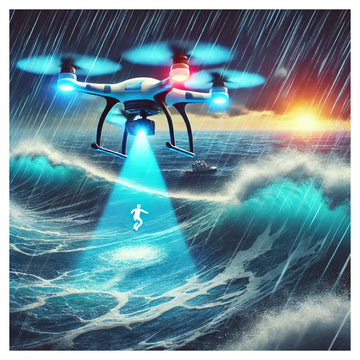In today’s fast-paced world, intelligent drones are revolutionizing rescue operations. With rapid technological advancements, the performance of these drones is crucial for saving lives during emergencies. This article explores actionable strategies to optimize drone systems, ensuring they are smarter, faster, and more reliable when every second counts.
1. Optimizing Autonomous Flight Control
Advanced Flight Controllers and Navigation
Intelligent drones rely on sophisticated flight control systems to navigate complex environments. By adopting state-of-the-art controllers—such as those built on the ArduPilot platform—drones can execute precise trajectory tracking and dynamic path planning. Refining navigation algorithms allows for:
- Accurate Autonomous Flight: Drones can adjust their flight path in real time, ensuring smoother operations even in unpredictable rescue scenarios.
- Robust Sensor Fusion: Integrating inputs from GPS, inertial measurement units (IMU), and barometric sensors enhances overall stability and response to environmental challenges.
Enhancing Interference Resistance
Rescue missions often occur in areas with high electromagnetic interference or adverse weather conditions. Strengthening anti-interference measures through advanced multi-sensor fusion techniques ensures that drones maintain operational integrity even when external disturbances are prevalent.
2. Enhancing Imaging and Processing Capabilities
High-Resolution Image Capture
High-quality visual data is key in search and rescue. Equipping drones with high-resolution cameras that integrate real-time GPS tagging and time-stamping can significantly improve situational awareness. This capability enables:
- Timely Decision Making: Rescue teams receive live, accurate images of disaster zones, helping them to quickly assess and respond to emergencies.
- Precise Target Identification: Enhanced imaging quality assists in pinpointing the location of survivors or hazards.
Advanced Computer Vision and AI Algorithms
Leveraging powerful computer vision frameworks like OpenCV and YOLO (You Only Look Once) can dramatically increase the speed and accuracy of target detection. Deep learning models trained on diverse rescue scenarios allow drones to:
- Quickly Detect Critical Elements: From identifying stranded individuals to spotting dangerous obstacles, AI-driven image processing refines detection accuracy.
- Adapt to Varied Environments: Continuous algorithm improvement ensures that drones remain effective across diverse rescue landscapes.
3. Improving Propulsion and Energy Efficiency
Selecting Optimal Power Sources
A key factor in drone performance is the propulsion system. Using advanced power sources such as proton exchange membrane fuel cells can provide higher efficiency and longer endurance. By modeling and understanding how atmospheric conditions (e.g., altitude, temperature) affect power output, engineers can:
- Maximize Energy Output: Optimize current density and hydrogen intake to boost voltage and overall power efficiency.
- Enhance Flight Duration: Lightweight, efficient power systems contribute to longer mission times, critical in rescue operations.
Thermal Management and Weight Optimization
Effective thermal management prevents overheating during extended flights, while a lightweight design improves overall agility. These considerations are vital in:
- Sustaining High Performance: Ensuring that power systems function reliably under continuous operational stress.
- Increasing Payload Capacity: Allowing drones to carry additional equipment without compromising flight dynamics.
4. Strengthening Communication Networks
Long-Distance, High-Frequency Communication
In rescue scenarios, maintaining a secure and stable connection between drones and ground control is non-negotiable. Implementing high-frequency communication technologies like 5G can significantly enhance:
- Data Transmission Speed: Enabling real-time video and telemetry sharing.
- Signal Stability: Reducing latency and minimizing the effects of interference.
Multi-Drone Coordination
In large-scale rescue efforts, collaboration among multiple drones is essential. Establishing a distributed communication network allows for:
- Seamless Information Sharing: Drones can coordinate their movements and share sensor data in real time.
- Enhanced Operational Efficiency: Coordinated missions lead to quicker, more effective rescue operations.
5. Boosting Adaptability and Reliability
Designing for Harsh Environments
Rescue operations can occur in extreme conditions—from rugged mountains to flood-prone areas. To ensure drones perform under such circumstances, manufacturers should focus on:
- Ruggedized Build: Utilizing materials and designs that offer waterproofing, dustproofing, and shock resistance.
- Environmental Adaptability: Ensuring drones are capable of functioning reliably in high winds, extreme temperatures, and other challenging conditions.
Rigorous Testing and Fault Diagnosis
System reliability is paramount. Implementing extensive testing under various conditions and integrating advanced fault diagnosis systems helps:
- Preempt Potential Failures: Early detection of issues minimizes downtime during critical missions.
- Maintain Operational Continuity: Consistent performance through built-in redundancy and fail-safe mechanisms.
Conclusion
Enhancing the performance of intelligent drones in rescue operations involves a multi-faceted approach. By optimizing flight control, refining imaging and processing capabilities, improving propulsion efficiency, strengthening communication networks, and boosting adaptability, the drone rescue systems of tomorrow will be more effective than ever. Continuous innovation and rigorous testing remain the cornerstones of advancing this transformative technology, ultimately saving more lives when it matters most.
If you found this article insightful, share it with colleagues and stay updated with the latest trends in drone technology by subscribing to our blog.





